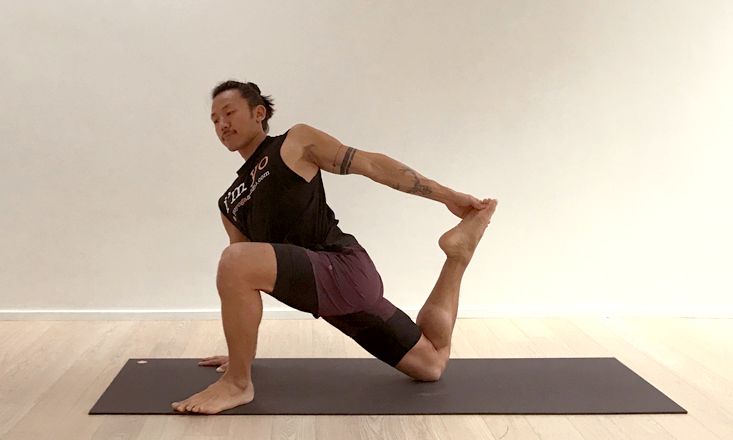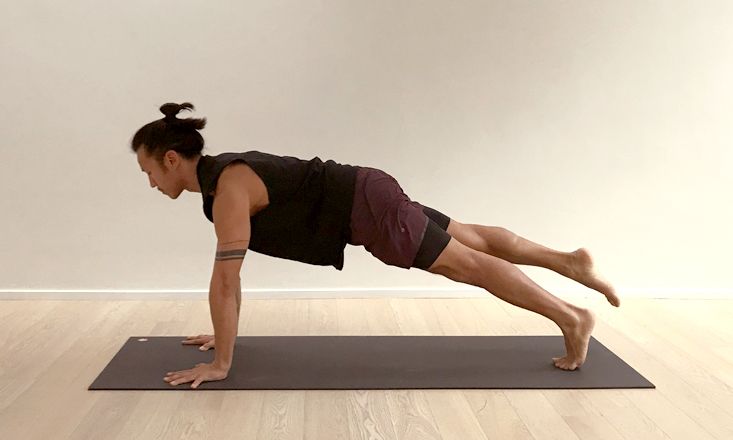Asana yoga classes are an excellent way to connect with, and increase awareness of, the body. In yoga class, it’s common to hear anatomical terminologies used to refer to the body, particularly in identifying muscle groups, bones, and joints.
While the average student might not know what the iliopsoas actually is, it is a sure bet that it has been mentioned in at least one class they have attended.
The Iliopsoas Defined
More commonly shortened and referred to as the psoas, iliopsoas refers to the joined psoas and iliacus muscles. It is the strongest muscle of the hip flexor group, originating in the upper vertebra of the lumbar spine and attaching to the lesser trochanter of the femur (a tiny prominence near the head of the thigh bone).
It is the only muscle that connects the lumbar spine to the lower body and as such, has a huge impact on posture and optimal performance in physical movement—yoga included.
The psoas is (partly) responsible for facilitating hip flexion, or drawing the thigh and the spine towards each other. Postures like Navasana and Bakasana, where deep hip flexion is required, will activate the psoas.
When the psoas is tight, it might be felt in backbends like Ustrasana (Camel pose) or Setu Bandhasana with the lumbar spine hyperextended. As a result, to lengthen the psoas, think about postures that open up the front line of the body. To strengthen the psoas, consider poses wherein the front of the thigh is actively moving towards the front of the abdomen—or more subtly, using the psoas to hold the pelvis in neutral.
If you’d like to learn more about the psoas and poses that engage it, I suggest you sign up to the 30 Day Yoga Challenge. A regular and consistent practice will help you gain strength and increase flexibility.
For now, let’s have a closer look at the following poses that will help lengthen and strengthen the psoas.
1. Low Lunge or Anjaneyasana
This low lunge with the back knee down is an accessible posture that helps to lengthen the psoas of the back leg. With the front leg forward and the knee bent at 90° above the heel, have the back knee down and under the hip or slightly behind it.
Draw up through the hip points to maintain length in the lumbar spine, while allowing the pelvis to sink forward and down as you exhale. The hands can rest on the front thigh, or the arms can reach upwards.
2. Twisted Lizard or Parivrtta Utthan Pristhasana
Twisted Lizard pose deepens the stretch you receive in Anjaneyasana. From Adho Mukha Svanasana (Down Dog), step the right foot forward outside of the right hand. Keep both hands in the same line as the front foot.
With your back knee down on the mat, bend the back leg bringing the heel towards the buttock. Take the right arm behind you and hold the outer edge of the back foot. On an exhalation, bend the right elbow pulling the left heel closer towards the glute.
This is a big opening for the quadriceps of the back leg. Focus on lifting the front of the hip bones towards the navel to lengthen the psoas.
3. Apanasana or Pavanmuktasana
Start in constructive rest or Ardha Savasana, with the legs bent so the knees sit directly above the heels. Bring the right knee towards the chest, interlacing the fingers on top of the shin bone, and pulling the thigh against the right side of the abdomen and chest.
Keep the muscles around the right hip relaxed. Begin to walk (or slide) the left foot forward bringing the left leg as straight as you can onto the mat. As you extend the left knee, focus your attention at the front of the left hip. Energetically ground through the back of the left leg, particularly the inner thigh which will help to lengthen the left psoas.
4. Modified Boat or Navasana
Begin in Dandasana with the spine lifted and lengthened. Bend the knees so the heels are closer towards the buttocks with the soles flat on the mat. Bring both arms forward, and while maintaining the length of the spine, begin to lean back.
The weight of the torso is being pulled to the floor but it is the contraction of the psoas that helps to keep the spine aligned. This modification of Navasana is a great way to strengthen the psoas.
In the full pose, Puripurna Navasana, the heels are lifted in line with the knees (or the legs completely straight) with a focus on keeping the spine in axial extension, as it will want to flex. Recruit the psoas to keep the thighs and front body towards each other.
5. One-Legged Plank Pose
From Table Top pose, step the feet back into a high plank. Stack the shoulders above the wrists so the arms are vertical, and neutralize the spine, ensuring the pelvis isn’t collapsing towards the earth.
Inhale–gaze forward and exhale–lift the right foot to a hover. Draw the hip points forward towards the chest to help maintain a neutral pelvis. The psoas of both legs will activate, and as a result, strengthen to keep the pelvis stable. Specifically, the psoas of the right leg will stabilize the lifted leg, and the psoas of the left leg will stabilize the pelvis.
Note: Asymmetrical postures to be done on both sides (1, 2, 3, 5).
The psoas is a key player in our yoga practice. Our ability to move through our asana practice with ease can be dependent on our psoas being strong and flexible.
Beyond the mat, the psoas also directly impacts our posture, making it an important muscle to strengthen and lengthen. In doing so, we can relieve lower back pain, improve our overall posture, and feel stable in our bodies.








